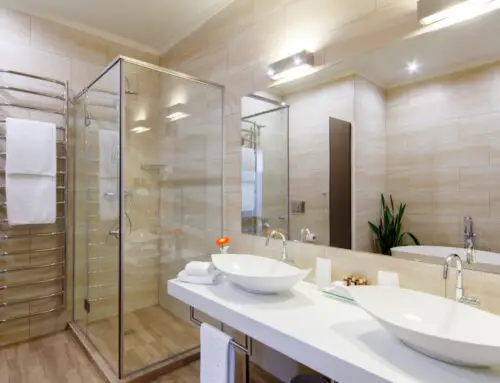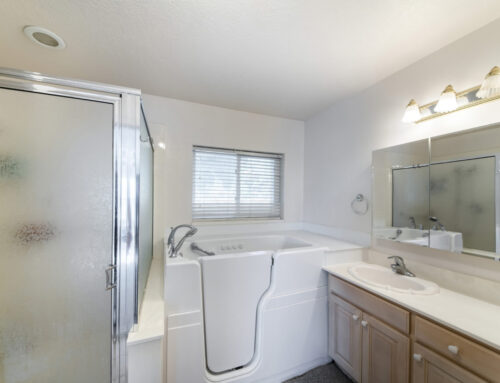A shower standing handle, also known as a safety shower handle, is an important mobility and safety accessory that can assist individuals while showering. Shower handles provide support and stability, allowing you to confidently and securely stand in the shower. With many options available, it’s important to understand the different types of shower handles and choose one that fits your needs.
Understanding Shower Standing Handles
A shower standing handle is a type of shower grab bar or handle that is installed in your shower to provide support and stability while in a standing position. It allows you to safely balance and stand while bathing, preventing slips or falls. Shower handles come in various designs and can be installed in different ways, but ultimately serve the same purpose – to give you an additional point of contact and grip to improve shower and bathroom safety.
The Importance and Uses of Shower Standing Handles
Using a shower standing handle is extremely beneficial for multiple reasons:
Increased Bathroom Safety – Holding onto a fixed shower handle gives you an additional handhold to stabilize against, preventing falls or slips while standing in the wet shower. This minimizes accidents and injuries.
Assistance for Mobility Issues – For those with medical conditions like arthritis, loss of strength or balance, shower handles allow independence and ease while bathing. It provides support for those who struggle to stand unaided but don’t want a shower chair.
Convenience – Unlike a shower grab bar, some handles can be easily installed without drilling into tile. This offers convenience for those wanting temporary assistance or for rental properties.
A secure handhold can make all the difference for confidence and safety during showering. Understanding the variety of handles available allows you to find the right solution to match your needs.
The Different Types of Shower Standing Handles
There are a few main types of shower standing handles available:
Suction Shower Handles
Suction shower handles use rubber suction cups that adhere directly to your shower wall tile. This allows them to be installed without drilling or permanently mounting to the wall. Most suction handles have lock modes to securely affix the suction cup against the wall.
Benefits:
Temporary and removable
Easy to install without tools
Often adjustable
Considerations:
Suction may weaken over time
Not as sturdy as permanent handles
The surface needs to be smooth for the suction cup to adhere
Permanent Shower Handles
Permanent shower handles are fixed directly into your shower walls, requiring drilling into tile or drywall for installation. The screws and mounting plates provide the most durable and sturdy support.
Benefits:
Very sturdy and durable long-term
Can hold heavier weights
Doesn’t weaken over time like suction
Considerations:
Permanent installation
More difficult installation
Adjustable Shower Handles
Adjustable shower handles allow custom positioning at different angles and heights. Many feature easy thumb screws to reposition the handle as needed.
Benefits:
Adjusts to proper ergonomic position
Can be repositioned if installed improperly
Accommodates multiple users
Considerations:
Plastic adjustment joints may wear out over time
Generally lower weight capacity
There are also specialized handles like padded handles or handles with shelves or soap dishes. Evaluate your needs to select the shower handle type that fits your requirements.
Benefits of Using a Shower Standing Handle
Using a shower standing handle has many helpful benefits:
A. Increase Safety
One of the main benefits shower handles provide is increased safety and stability while standing in the shower. They give you an additional grip to prevent slips, especially important with wet and slippery surfaces. Per national statistics, over 234,000 injuries occur yearly from non-fatal bathroom falls. Shower handles allow you to stand safely, minimizing your risk of becoming another statistic.
For example, a suction grab bar has over 22 pounds of gripping force to stabilize against. Having this backup support can prevent devastating falls that risk serious injuries. The peace of mind knowing you have this fixed grip for balance makes standing in the shower less risky.
B. Promote Independence for Those with Mobility Issues
Shower handles allow those with injuries, age-related mobility reduction, or medical conditions to confidently shower with independence. Conditions like arthritis, surgery recovery, and joint pain can make standing unaided difficult and dangerous.
The stationary support of a shower handle provides the stability needed for those with strength, muscle, or balance issues. It offers an anchor to take pressure off the body and eases movements like turning, bending, or reaching. This allows safe showering without needing the assistance of another person, providing independence in personal care.
C. Convenience
Unlike permanent grab bars, certain shower handles like suction-cup handles can be installed without drilling or mounting hardware. This offers convenience for those wanting temporary assistance or for rental housing units where alterations are restricted.
Suction handles can be placed and removed quickly without affecting the shower tile. No need to worry about filling holes or patching pieces when removing either. This convenience and customizability allow you to take handles between homes or while traveling too.
Factors To Consider When Choosing a Shower Standing Handle
There are a few key factors to evaluate when selecting a shower standing handle:
A. Material
The material of your shower handle influences its moisture resistance, durability, and grip. Common handle materials include:
Stainless Steel – Most moisture resistant. Provides very durable construction too but can be slippery.
Aluminum – Light yet sturdy. Corrosion-resistant for humidity but may not last decades.
Plastic/Acrylic – Very lightweight handles but not quite as durable over many years. Plastic threaded joints tend to wear out.
Consider longevity, bathroom humidity exposure, cleaning agents used, and your weight to determine the best material that suits your needs. Metal handles generally provide better lifelong performance.
B. Weight Capacity
Verify that any shower handle meets your minimum weight capacity needs plus additional buffer. Suction-cup handles often support 200-300 lbs while permanent handles support over 500 lbs. If the handle is not rated to hold your full weight, it risks detaching and failing when relied upon. Always choose a handle that exceeds your actual weight.
C. Installation Options
Decide whether a permanent or temporary handle is best for your situation. Permanent handles require drilling into tile and wall studs but offer the most secure foundation long-term. Temporary suction models adhere to smooth surfaces, are easily removable, and don’t affect walls making them ideal for rentals.
First, determine if drilling modifications are permissible for your home before deciding on a permanent handle requiring custom mounting.
D. Comparing Types
Take your specific needs and requirements into account when reviewing available shower handle options. If wanting to take a handle while traveling, a suction bar that packs away suits this better than a fixed handle. If needing to support over 300 lbs regularly, a permanent stainless steel handle is likely the safer choice over a suction version.
Create your criteria like weight capacity, installation method, storage, budget, etc. to narrow down suitable choices. If unsure what fits best, consult an occupational therapist for personalized recommendations.
Choosing a Shower Handle for Someone Else
When selecting a shower handle for someone else, consider their specific condition, requirements, and shower layout.
For an elderly adult – As we age, factors like arthritis, osteoporosis, vision impairment, and reduced balance can increase fall risks. Choose sturdy supportive handles, angled ergonomically for ease of reach, and optionally with contrasting colors if vision impaired. Suction may become less reliable over their expected years of use.
For a person with disabilities – If assisting someone with physical disabilities or conditions affecting mobility, grip, and strength, consult their occupational therapist for customized advice based on their challenges. Needs such as seat handles, fastening location, arm reach, etc. will vary by each individual and their limitations.
Evaluate their current ability, rate of decline, and anticipated future needs when selecting appropriate shower handles for them. An occupational therapist can best analyze and recommend what suits individual cases.
Installation Guide for Shower Standing Handles
Properly installing your shower handle securely is vital for functionality and safety. Here are general directions for installing common shower standing handles:
A. DIY Installation Steps
Suction Handles
Clean the wall area thoroughly where handle suction cups will adhere. The surface should be smooth and dirt/soap-free.
Some handles have locking tabs or rotate to engage stronger suction. Toggle these into the “on” fixed mode per product instructions.
Firmly press suction cups flat against the shower wall for 30 seconds minimum, especially after the first application. Engage any locking devices.
Attempt to pull the handle off the wall without twisting or angling. If it detaches, repeat step 3. The handle should fully support your weight without moving.
Check suction adhesion monthly and re-affix the dhandle firmly when any loosening occurs. Replace suction cups every 1-2 years.
Permanent Handles
Confirm stud location prior to drilling to ensure screws mount properly into wall structure support.
Follow manufacturer template guidance for accurately positioning handle mounting plates.
Drill holes into the wall at marked locations. Insert wall anchors first if drilling into tile or drywall only.
Secure the mounting plate or handle ends flat against the wall using all provided screws. Tighten firmly.
If adjustable, position the handle to the desired height/angle and tighten all locks and joints.
B. Professional Installation
For permanent handles, consider hiring a handyman or contractor for installation, especially if unfamiliar with or uncomfortable drilling into walls and pipes yourself. They can locate studs, use fasteners appropriately, and ensure a safety-code-compliant mounting.
Professionals also have specialized tools to guide drilling angles and detect potential electrical lines. This offers peace of mind knowing your permanent grab bar was properly installed for structural integrity.
For those physically unable to install their own handle, a caregiver or assisted living service can also assemble on your behalf.
Getting a Handle on Questions
Here are answers to some frequently asked questions about shower standing handles:
How much weight can shower handles hold?
It depends on the handle, but most support 200-400 lbs. Some permanent stainless steel handles hold over 500 lbs. Choose a handle rated at least 50 lbs beyond your weight.
Where should you place shower handles?
Install either perpendicular to or along the shower’s entryway. Having one end easily reachable from outside the shower ensures you have support before fully entering.
How do you determine proper handle height?
The handle should be positioned for each bather’s comfort and needs. General advice is to install 30-34 inches above the shower floor, angled slightly downwards for an ergonomic grip.
Can you install a shower handle on acrylic or fiberglass surrounds?
It’s not advisable to drill into acrylic, fiberglass or plastic surrounds. These materials can crack, splinter, and lack reinforcement strength. Use clamp-on handles or consider adding wood support backing.
How long should shower handles last?
High-quality permanent handles last 10-15 years or more. Suction handles vary greatly but typically last 2-5 years with proper maintenance before suction fatigue sets in. Check handles regularly for any loosening or damage.
Is it OK to use shower handles to fully bear your weight?
Yes, provided it’s rated to exceed your weight capacity with a safety margin. Shower handles are designed to fully support you, not just occasionally stabilize or assist.
How can I maintain my shower handle?
For permanent handles, inspect fittings yearly and tighten any loose screw joints. Seal any gaps that allow water intrusion behind it. Clean regularly with non-abrasive soap and water. Replace suction cups every 1-2 years.
Conclusion
Installing shower standing handles enhances bathing safety, allowing confident standing and stabilization against falls. Permanent and temporary handles suit different installation needs. Consider key factors like handle strength, materials, placement, and your physical requirements when selecting the most appropriate solution. Properly chosen and positioned handles provide dependable support for years, greatly reducing slip risks while showering. Investing in this affordable safety addition can prevent devastating and costly injuries for both yourself and your loved ones.



